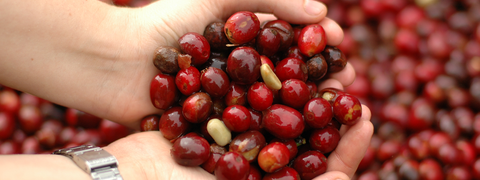Coffee Plant Basics
Share
Written by Allana Kennedy, Roaster at Outpost Coffee Roasters
Over two billion cups of coffee are consumed worldwide daily, making coffee the second most traded commodity below crude oil. While it is a hot delicious commodity it seems to also be undervalued with most consumers wanting a cheap cup without understanding the process of how the coffee bean goes from farm to cup. Do you know where your coffee comes from? Did you know that the coffee bean is actually a seed?
Below I will outline the basic structure of the coffee plant and its cherry- the fruit of the coffee plant.
The Coffee Plant
Coffee is one of the oldest traded commodities, with the first coffee plant found in Ethiopia in the 11th century. There are two species of the coffee plant: Arabica and Robusta. While the species of Arabica comprises of several different varietals, it is by far the most popular accounting for around 70% of all coffee produced. Of the two strains, Arabica is more vulnerable to diseases but has a more pleasurable flavour. Robusta on the other hand has a higher caffeine content and grows at a lower altitude but is known for its bitterness.
An Arabica coffee plant can produce fruit after its second or third year and at seven years old it will reach full maturity. A coffee plant will typically produce cherries for 25-30 years. Depending on terroir (climate, soil and altitude) and the varietal, producers can expect to yield around 5kgs (10lb) of coffee cherries each harvest from one tree.

From the start of flowering to harvest time will take approximately 9 months. Once the cherries are ready to harvest, pickers will have roughly 8-10 days to pick them before they become overripe. Pickers must pick each tree a few times as each cherry will ripen at different times. Surprisingly, every 2-3 years a coffee plant has a 'down-year' where it will not produce any fruit, and will regain its strength for the next season.

The Coffee Cherry
Skin/Pulp
The first layer is the cherry skin, which starts green and then ripens into red, yellow or orange depending on the varietal. With the exception of Natural Processed coffee, this outer layer is removed within a few hours of harvest. The skin is mostly considered a by-product however some make 'Cascara' tea out of the skin as it has caffeine and is very sweet. Most farms will use the skin as fertilizer as shown in the photo below, where the skin is left to ferment and compost in an area before being spread around. The smell is enough to get you drunk.

Mucilage
Under the skin lies the mucilage, this is a sticky, sweet substance surrounding the seeds. This layer is full of sugar and is the most important part in the fermentation process. Since the mucilage is so sticky and sugary, it can be dried on the seed and this is known as Honey Process.
Parchment
The next layer after the mucilage, is a layer of cellulose which protects each of the coffee seeds. When dried, this layer looks and feels like parchment paper, hence the name. This layer is removed by hulling, a part of the milling process usually done before exporting.

Silver skin/Chaff
Further inside, an even thinner layer coats the seed. This layer is called the silver skin because of its somewhat silvery sheen. This layer comes off during roasting. If you ever notice golden flakes in ground coffee, that is usually bits of silver skin or chaff that didn’t separate from the beans during the roast process.
Seed/Coffee Bean
What is known as the coffee 'bean' is actually one of the two seeds from inside the coffee cherry. Peaberries are an anomaly in which only one large, round seed forms inside the cherry. Usually about five percent of all coffee is graded as a peaberry.

In my next blog I will explore how flavour is impacted by each stage of processing of the coffee cherry.


